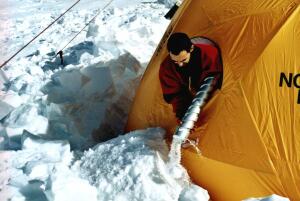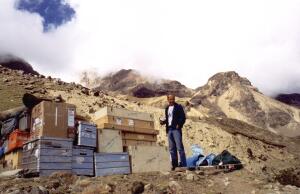SIMPLIFIED ICE CORE DRILLING AT HIGH-
ALTITUDE- GLACIERS DOWN TO BEDROCK

Ice core recovered at Illimani |

Drill site at Illimani (6400masl) |
Abstract
The conventional system of drilling by wire is much
simplified by omitting the outer barrel. With a functional
redesign a very reliable and simple to use drill results. The net
weight of the complete drilling system is about 150 kg and can be
broken down into seven handy porter loads.
Even for a novice team it is possible to drill down to bedrock at
difficult to reach glaciers in a very short time.
This paper is based on the French- Swiss IRD & PSI
Expedition to Illimani (Bolivia). The 3rd of June 1999 we reached
bedrock at a depth of 138,7 m after six working days at an
altitude of 6400 masl.
3 Inch ice drill
We designed and manufactured this ice drill during 1998.First tests end of
September 1998.
Final test December 1998
First real life use at the Paul-
Scherrer- Institute (PSI) Expedition to Cerro Tapado, February 1999 (Chile,
5500 masl)
Second use at Illimani, June 1999. The Illimani - Expedition was
a joint- venture of PSI and IRD Monpellier.
Also successfully used at Chimborazo,
November 2000 (Ecuador, 6250masl)
No Outer Barrel
Obviously the work with an ice core drill can be much simplified
if there is no outer barrel; the construction and manipulating of
the coupling between the core barrel and the drive unit will be
much simpler and the working space can be restricted, so it will
be possible to work protected inside a tent.
The task of the outer barrel is twofold; it guides the chips
upwards and prevents the core barrel of seizing in the drilled
hole.
To prevent the chips turning round with the core barrel and
blocking the core barrel we raised the revolutions of the drill
to 220 revolutions per minute. The centrifugal force is now
sufficient to throw the chips in contact with the wall of the
drilled hole. Even in a smooth hole in compact ice there is no
difficulty transporting the chips.
The transporting spirals on the outside of the core barrel are in
complete contrast to the conventional design; they are narrow and
machined out of a thick walled alu tube. As their breadth is
continuously increasing to the top, there is nearly no danger of
blocking the drill in the hole. Inherent in every drilling
process is the danger of blocking the drill if drilling is
continued when the space available for the chips is filled.
A very simple system was developed to couple together the
following three parts of the drill; the core barrel, the chips
barrel and the drive unit. Two spring loaded pistons glide radial
into two holes of the thick walled barrel. To disengage it is
only necessary to push an U- shaped plate into tangentially slots
of the barrel.

Clutch engaged |

Clutch released |
The One- Piece Cutting Ring
Instead of individual cutting teeth we machined a complete ring
with two cutting teeth out of a solid block of a special hard alu
alloy. Even for non technicians it is very easy to replace a
cutting ring, as no adjustments are to be made.
One of these two teeth cuts some millimeters deeper but only a
narrow ring around the core. The second tooth cuts later the
outer part of the annulus. As the length of the cutting edges are
together only the breadth of the ring we have never problems of
insufficient cutting pressure.
The cutting edges can be restored or modified in the field with
some needle files, one cutting ring cuts easily a core length of
100m. At Chimborazo significant ash layers were drilled whiteout excessive wear.
The core dogs follow the conventional design, three different
sizes are used for firn, soft ice and hard ice.
The Anti- Torque
The torque of the drive motor is transmitted to the ice with
three hollow- cut, spring- loaded knifes. To prevent blocking
with ice- meal they fit snugly in slots of the drive- unit
casing. Although the connection with the cable is equipped with a
slip- ring we never sensed a slipping of the anti- torque.

Cross- section through Anti torque |

Detail of Anti torque |
The Cable
At Illimany we used a very sturdy and simple steel cable, weight per
100 meters is 14 kg. Outer diameter is 6 mm with a rupture load of 20 kn. .
In the center is a copper conduit of 1 mm2. The specific conductivity is 1.8
Ohms per 100 meters for the copper lead and 1.5 Ohms per 100 meters for the
steel mantle.
As the output power of the control box for the drill is 120
volts by 2 amps the loss in the cable is 8 % at a drilling depth of 150 m.
The
cable is quite stiff, so it can withstand a lot of rough handling.
At Chimborazo
we have changed to the lighter Schlumberger 4 - 18 PSS cable. It weights 9.7
kg/ 100m and has 4 conduits of 0.22 mm². With this cable we have higher
but still acceptable losses (20 % at 200m cable length).
Tower and Winch
Easy handling, handy transporting units and simple installation
were the aims in designing the winch and tower.
The cable drum is fixed by a axle with a bayonet coupling which also connects
the cable electrically.
The tower can be clicked together in seconds without any tools.
It is stabilized with four firn anchors outside of the protecting
tent.
Power Source
We supplied two independent power sources; a group of six
flexible solar panels with a peak power of 192 Watts and a small
gasoline generator with nominal 1000 Watts. These power sources
are connected with an accumulator pack ( capacity 840 Watt
hours).
The solar panels worked without problems and supplied enough
power to work the drill.
The gasoline generator ( HONDA EU 10 ) is really very compact at
only 12 kg and was completely reliable. Even starting in the
morning at temperatures at about -20C never posed any problems.
Due to the low air pressure at this altitude the power output was
reduced to about one third of nominal capacity (= 300W).
The Protecting Tent
| The complete drill is erected inside a North- Face big dome
tent. The only modification consist in a hole in the bottom to
pass the drill. The ice- cores are cut to uniform length and
packed in plastic envelopes inside this tent, the chips are
thrown out of a window. |
 |
Transporting Demand
The complete drill has a net weight of about 150 kg.The Cable drum with 200m
cable weights is the heaviest part with 28 kg. Even
in quite difficult alpinistic conditions the complete drill can
be transported in about seven porter loads. For road transport it
can be loaded inside a jeep or station wagon.
Performance
February 1999
In Chile at Cerro Tapado ( Altitude
5500 masl ) we drilled 35 m down to bedrock in one day, including installation
of the drill .
June 1999
In Bolivia at Illimani ( Altitude
6400 masl ) bedrock was reached by the Swiss drilling team at a depth of 138,7
m . As the working days were quite short in winter time we needed 6 days including
installation
The second core at Illimani was drilled by a French novice team
and reached bedrock after 7 days at 136,7 m . This time includes instructions
and training of the French team which never worked with ice-drills before.
November 2000
In Ecuador at Chimborazo (Altitude
6250 masl) bedrock was reached at 54 m. A total of 136m ice cores were retrieved.
In reasonable conditions it will be possible to drill 50m in 10 working hours
and for 150 m we will need about 50 working hours.
The drill can be installed
in less than one hour.
Home
FS Inventor AG. d.stampfli
Date: 02/01/01











